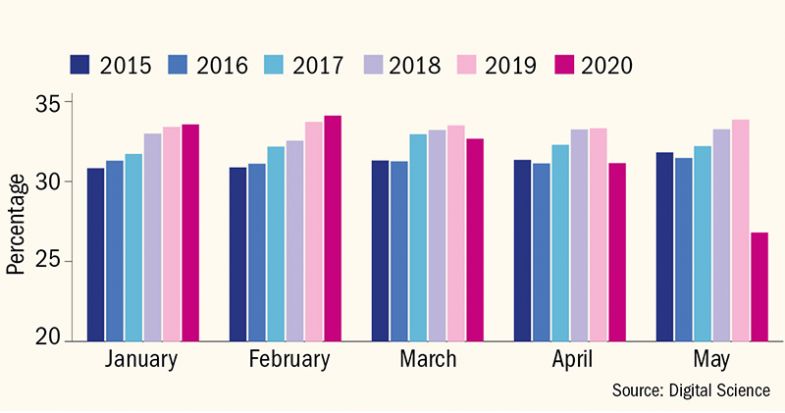Female academics have been hit particularly hard by coronavirus lockdowns, according to data that show that women’s publishing success dropped after the pandemic shut schools.
The results are some of the first to show that lockdowns may be taking a toll on women’s career-critical publication records, building on other studies demonstrating that the pandemic has also set back female researchers at the preprint and journal submission stage.
With lockdowns shutting schools the world over and forcing academics to look after children at home, it is feared that female scholars have borne a heavier childcare and housework burden than their male counterparts, prompting questions about how universities and funding bodies should respond.
“Universities will need to account for the pandemic’s gendered effects on research when making decisions about hiring, tenure, promotion, merit pay and so on,” said Megan Frederickson, an associate professor of ecology and evolutionary biology at the University of Toronto, who has also found that the pandemic has skewed research along gender lines in a separate analysis.
The latest data were compiled by Digital Science, a London-based company specialising in research analysis tools, using its Dimensions publication database to analyse more than 60,000 journals across all disciplines for Times Higher Education.
Proportion of research papers accepted where the first author is female, by month of submission over past five years

The analysis shows that the proportion of accepted papers with a female first author dipped below the historical trend for submissions made in March, April and May.
The decline in the share of papers by female first authors was particularly pronounced in April, when it fell by more than two percentage points to 31.2 per cent, and May, which saw a collapse of seven points to 26.8 per cent.
A more granular week-by-week analysis shows that the number of female first-author acceptances started to slip in mid-March and has dropped more steeply since late April.
School closures became mandatory in most countries around mid-March and are still fully or partially in place across most of the world.
There are caveats to the study. Because of the time lag between submission of a paper to a journal and acceptance, much of the data are not yet in, particularly for May, meaning the picture is still a partial one.
But at the same point last year, similarly incomplete data did not lead to female under-representation, Digital Science said, making the falls in female success less likely to be an artefact of data collection.
In addition, following the lockdown, the proportion of published papers in medical and health sciences disciplines has shot up as researchers scramble to understand the novel coronavirus and disseminate their results.
Women are better represented in these fields than they are in most others – representing 37.6 per cent of first authors over the past five years – meaning that, if anything, female publication success during the pandemic should have grown, not shrunk.
Worries in the research community about the lockdowns’ impact on women have been growing since mid-April, when several journal editors observed that submissions had become far more male-skewed since the imposition of lockdowns. Several studies looking at preprints have confirmed this.
This latest data from Digital Science, which has performed previous analyses on the gender split in research, reveal that the pandemic’s disproportionate toll on women is filtering through into published papers – the currency of academic careers.
That conclusion is “certainly in line with what I’m seeing” from other results, said Molly King, an assistant professor of sociology at Santa Clara University in California, who has studied inequalities in academic publishing.
The theory is that as lockdowns have increased domestic workloads – not just childcare, but homeschooling, shopping, cleaning and caring for elderly relatives – women have been landed with more tasks than men, and this has cut into their research time and exacerbated existing career hurdles.
Professor King pointed to survey data from the American Association of University Professors showing that even in normal times, female scientists do twice as much cooking, cleaning and laundry as male scientists, amounting to an extra five hours a week. Even in dual academic couples, women do more. “My hypothesis is that it would be the same with childcare,” she said.
One complementary explanation is that female academics, having only recently broken into some disciplines, are younger and so more likely to have small children. “So even if childcare duties are evenly spread within families with young children, there will be more men with older or adult children to skew the gender balance,” said Elizabeth Hannon, deputy editor of the British Journal for the Philosophy of Science and one of the first to notice that women were submitting fewer papers.
This hypothesis is supported by a survey of about 4,500 principal investigators in the US and Europe in mid-April, which found that having a child under five was the biggest factor associated with a drop in research hours. Women were more likely than men to have young children, partly explaining why they reported a larger drop in research time, according to “Quantifying the immediate effects of the COVID-19 pandemic on scientists”, a preprint posted to arXiv.
The question now is what universities can do to correct the blow to female productivity during the pandemic.
Professor King said universities should “explicitly not require any teaching evaluations from this spring as part of hiring materials” and should perhaps “recalibrate expectations” for publishing records during lockdown.
One difficulty, however, is that although female academics have been disadvantaged on average, this could hide all kinds of individual stories.
“I think universities (and funding agencies) will probably need to ask researchers to self-report how the pandemic has affected their research and make decisions on a case-by-case basis, but such a system will likely be imperfect,” said Professor Frederickson.
Meanwhile, some funding bodies have already begun working on a policy response.
In the Netherlands, the Dutch Research Council is in discussion with several female researcher groups to assess the impact of lockdown and has relaxed its funding rules to allow affected academics a second shot at applying for grants next year if, for example, childcare overwhelmed them at home.
A gender equality unit within Spain’s Ministry of Science and Innovation has also started looking into the pandemic’s impact on women’s research careers and has suggested that “compensatory measures” might be needed.
POSTSCRIPT:
Print headline: Women’s careers languish in lockdown, data show
Register to continue
Why register?
- Registration is free and only takes a moment
- Once registered, you can read 3 articles a month
- Sign up for our newsletter
Subscribe
Or subscribe for unlimited access to:
- Unlimited access to news, views, insights & reviews
- Digital editions
- Digital access to THE’s university and college rankings analysis
Already registered or a current subscriber?








